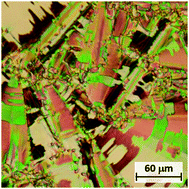New amphiphilic materials showing the lyotropic analogue to the thermotropic smectic C* liquid crystal phase†
Abstract
The recent discovery of a new lyotropic liquid crystal phase, the structure and properties of which are analogous to the chiral ferroelectric smectic C-phase (SmC*) in thermotropics, was based on a tailored amphiphile structure in which a tilt-promoting mesogenic core was linked to a chiral diol-headgroup via a hydrophilic ethylene glycol spacer [J. R. Bruckner et al., Angew. Chem., Int. Ed., 2013, 52, 8934–8937]. However, so far there is only one example of this general amphiphile structure known to form the new lyotropic SmC* phase in mixtures with water and with formamide. In an attempt to systematically elucidate the underlying structure–property relations we now report two new amphiphiles leading to lyotropic SmC* phases. These amphiphiles are derived from the parent amphiphile structure by (i) an elongation of the hydrophilic ethylene glycol spacer and (ii) an exchange of the original 2-phenylpyrimidine core by an even more tilt-promoting fluorenone core. Our investigations also reveal that the formation of the lyotropic SmC* phase is highly sensitive to exchanging or enlarging a building block of the primary material.

- This article is part of the themed collection: 2017 Journal of Materials Chemistry C HOT Papers


 Please wait while we load your content...
Please wait while we load your content...